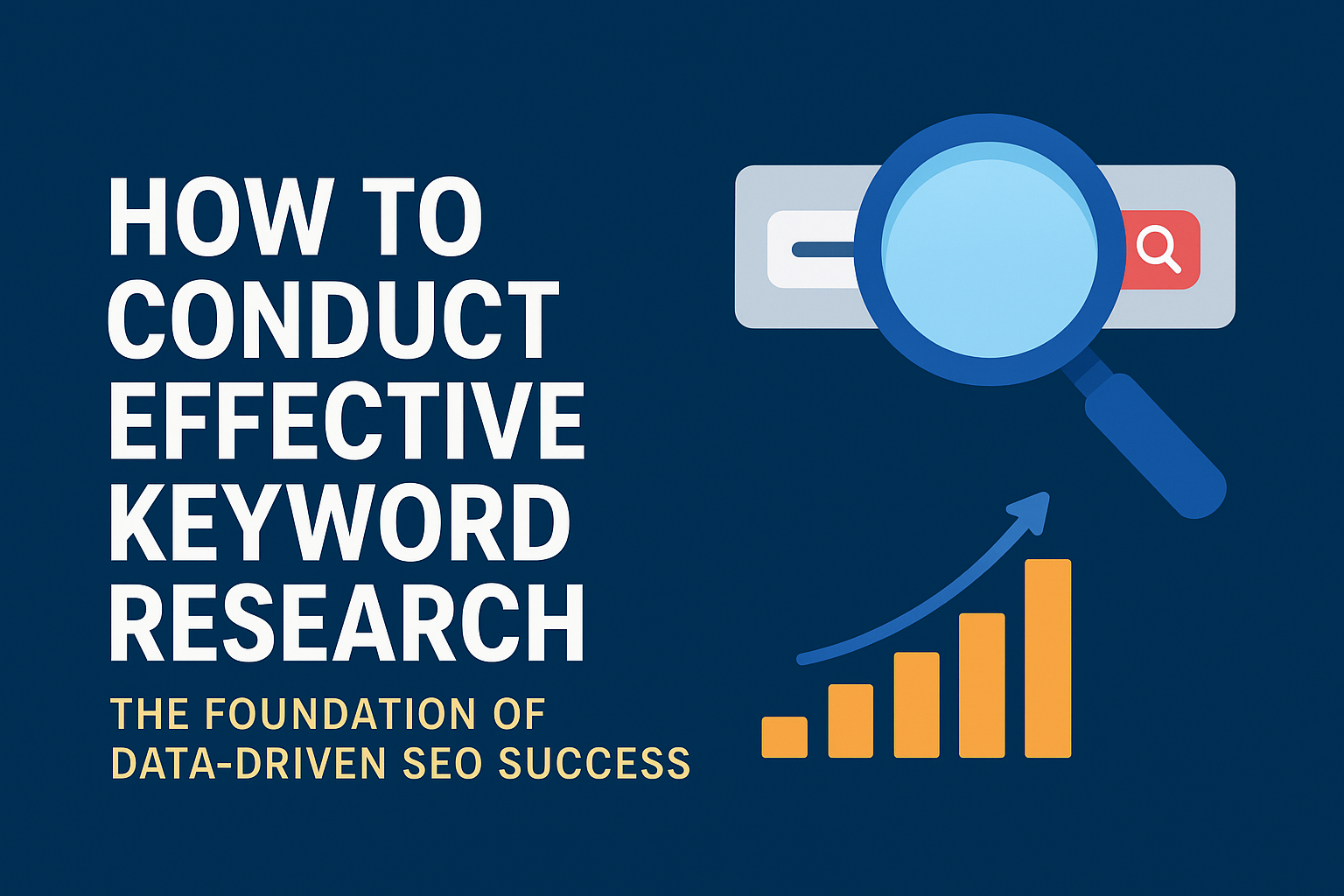In today’s digital economy, understanding how to conduct effective keyword research is essential for building a strong, measurable, and adaptable SEO strategy.
This whitepaper outlines a complete framework that helps organizations translate search intent into business growth through structured keyword discovery, performance metrics, and content alignment.
By mastering this process, brands can move beyond ranking alone—creating educational, conversion-focused content systems that generate sustained visibility, authority, and revenue.
1. The New Paradigm of Search Intelligence
Search Engine Optimization (SEO) has evolved from a purely technical practice to a discipline centered on data interpretation and behavioral alignment.
At its foundation lies the ability to identify and apply the right keywords—the phrases your audience uses to find solutions, products, or knowledge.
Organizations that understand how to conduct effective keyword research gain more than traffic; they develop predictive insight into consumer intent, enabling smarter content planning and more precise brand communication.
2. Decoding the Power of Keywords: The SEO Foundation
Keyword research remains the bedrock of every successful SEO campaign. It identifies the language users naturally employ and aligns it with a brand’s offerings.
By strategically integrating these keywords across digital assets, brands can improve their rankings, click-through rates, and user engagement.
Defining SEO Goals and Alignment
Every keyword strategy must begin with purpose:
- Are you optimizing for sales, brand awareness, or lead generation?
- Are your keywords aligned with customer journey stages?
Transactional keywords (e.g., “buy,” “best,” “discount”) serve performance goals, while informational ones (e.g., “how to,” “what is,” “guide”) build awareness and trust.
Pro Insight: Before investing in keyword research tools, define measurable KPIs such as traffic growth, ranking improvement, or conversion rate optimization.
3. Building Your Keyword Foundation: Seed Keywords
Seed keywords form the basis of your entire keyword strategy. They represent core services, industries, or topics that anchor your research.
Tool Matrix for Generating Seed Keywords
| Tool | Function | Use Case |
|---|---|---|
| Google Keyword Planner | Provides search volume and competition data | Establish baseline keyword demand |
| Google Autocomplete | Suggests real-time queries | Identify trending search phrases |
| Google Trends | Analyzes interest over time | Detect seasonality and market shifts |
| Ahrefs / SEMrush / Moz | Competitive keyword analysis | Benchmark performance vs. rivals |
| AnswerThePublic / Reddit / Quora | Extracts natural user queries | Capture conversational search terms |
| Customer Reviews & Feedback | Source of authentic language | Identify intent-driven long-tail opportunities |
Action Step: Combine insights from multiple tools to form a robust keyword seed list that reflects both market volume and brand-specific positioning.
4. Data-Driven Metrics: Evaluating Keyword Performance
Effective keyword research is rooted in measurable data. The following matrix illustrates the key performance indicators (KPIs) that inform strategic decisions.
Metrics and Interpretation Framework
| Metric | Definition | Interpretation & Strategic Use |
|---|---|---|
| Search Volume | Frequency of keyword searches | Prioritize medium-to-high volume keywords with realistic ranking potential |
| Keyword Difficulty (KD) | Competitive intensity of ranking | Target moderate KD terms to balance visibility and effort |
| CTR (Click-Through Rate) | Share of impressions converted into clicks | Use compelling meta titles and rich snippets |
| Conversion Rate | Percentage of visitors who take desired action | Optimize landing pages around intent-matched keywords |
| Relevance Score | Alignment with business offering | Focus on queries that directly match your service or content |
| Seasonality | Demand fluctuations across time | Adjust editorial calendar to reflect peak search periods |
| Local & Mobile Relevance | Geo-intent and device impact | Localize keywords for markets like Pakistan, UAE, and KSA |
5. Understanding Search Intent
Search intent determines why users perform a query. Recognizing and classifying this intent ensures that your content meets both informational and transactional needs.
Visual Matrix: Intent Type, Example, and Recommended Content
| Intent Type | Example Query | Recommended Content Type |
|---|---|---|
| Informational | “What is keyword research?” | Educational blogs, guides, infographics |
| Navigational | “Warsi Entrepreneurs SEO services” | Landing pages, about pages, brand story |
| Transactional | “Buy keyword research tool online” | Product pages, offer-based CTAs |
| Commercial Investigation | “Best SEO agencies in Pakistan” | Comparison posts, case studies, testimonials |
| Local Intent | “SEO consultants near me” | Localized service pages, Google Business profiles |
Strategic Tip: Align every keyword cluster to one intent type. This ensures your content ecosystem covers all funnel stages effectively.
6. Keyword-to-Content Mapping Blueprint (Action Layer)
Transforming keyword data into a structured content architecture requires clear mapping between intent, format, and objective.
Framework: From Keyword Insight to Execution
- Identify Core Topics — Based on your seed keywords and primary goals.
- Cluster by Intent — Group informational vs. transactional queries.
- Assign Content Type — Blog, video, case study, landing page, or FAQ.
- Define Performance Metric — CTR for blogs, conversion rate for service pages.
- Integrate Semantic Keywords — Use NLP tools for natural keyword variation.
- Monitor & Refine Quarterly — Remove underperforming terms and adapt to SERP shifts.
This process ensures that how you conduct effective keyword research directly translates into a measurable, content-driven ROI cycle.
7. Bridge to Implementation: Adaptive Intelligence Layer
To operationalize this keyword system, businesses must establish a feedback intelligence layer integrating:
- Search Console & NLP Analysis: Real-time intent reclassification.
- Engagement Scoring Models: Track bounce rate, dwell time, and conversion depth.
- AI Optimization Loops: Detect SERP intent shifts and trigger content pivots.
- Cross-Channel Relevance Mapping: Link SERP, social, and email journeys.
This layer ensures your SEO strategy evolves dynamically alongside algorithm updates and market changes.
8. Conclusion: From Search Intent to Strategic Growth
Understanding how to conduct effective keyword research provides more than visibility—it delivers strategic foresight.
When executed systematically, keyword research becomes the foundation for content planning, funnel optimization, and predictive audience modeling.
By aligning data with user intent, organizations transform SEO from a technical function into a long-term growth mechanism—bridging marketing, analytics, and brand strategy under one unified framework.
9. Consultation CTA: Transform Your Keyword Framework into a Revenue Engine
If your organization seeks to move beyond basic keyword targeting toward a conversion-centric, education-led SEO framework,
Warsi Entrepreneurs offers an enterprise-grade methodology to help you master how to conduct effective keyword research at scale.
Deliverables Include:
- Custom keyword architecture audit and gap analysis
- AI-powered semantic clustering for content planning
- Competitive benchmarking with conversion mapping
- Continuous analytics and reporting dashboard
📞 Schedule a Consultation:
Visit warsientrepreneurs.com/contact-warsi-entrepreneurs
or email strategy@warsientrepreneurs.com to book your Data-to-Conversion Strategy Session.


